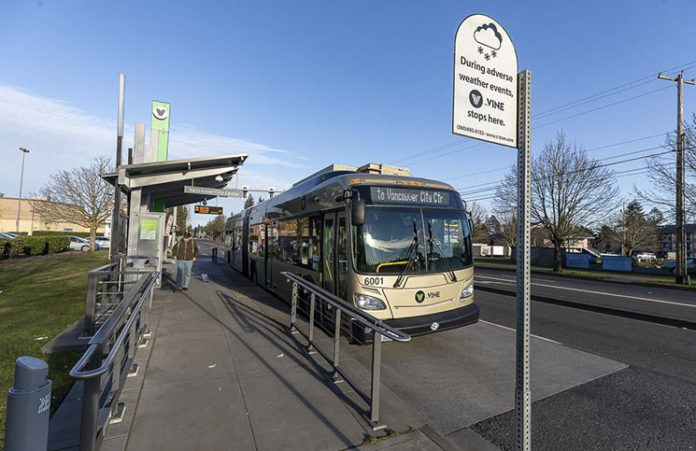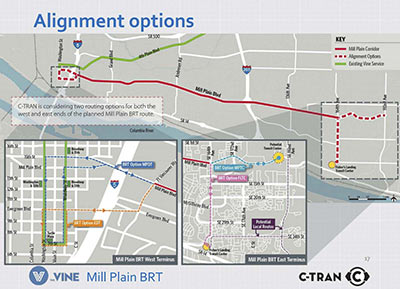
C-TRAN is hitting the accelerator on plans to bring Bus Rapid Transit to Mill Plain.
At a February work session during a C-TRAN board meeting, Chief External Affairs Officer Scott Patterson outlined why Mill Plain became the next step in their expansion of The Vine, and where they’re at in the process.
C-TRAN is expected to give final approval to a locally preferred alternative for the new BRT line in either March or April, so things could change in the meantime, but it appears the Mill Plain Vine route is pretty much set.
It’s expected to run about 10 miles, from a new transit station on the east end at 192nd, south of Mill Plain, to Turtle Place in downtown Vancouver, where the Fourth Plain Vine currently ends.
One surprise to come out of the Corridor Advisory Committee and Technical Advisory Committee was a recommendation that the west side of the route use East Evergreen Boulevard in downtown Vancouver, rather than remaining on Mill Plain.
“As somebody who lives north of Mill Plain, I see this as a huge whack in the shins of the Arnada and Hough neighborhoods,” said Vancouver City Councilor and C-TRAN board member Ty Stober. “This alignment down Evergreen, in my opinion, really knocks out the north neighborhoods from wanting to utilize that to transit to jobs, for instance.”
But Patterson said their study showed the Evergreen alignment better addressed transit service improvements, safety and future demand, while also being a more cost-effective long-term solution.
“We have a third BRT corridor planned for the future as well that would run north-south along Highway 99 into downtown Vancouver,” Patterson said, noting that using the Evergreen alignment would free up the west end of Mill Plain to eventually be the southern terminus for that BRT line.

At the meeting, C-TRAN Chief Executive Officer Shawn Donaghy said they have secured Federal grant money to proceed to the planning phase of the Mill Plain BRT project. Patterson added that they’ve reached this point in just a year, where the Fourth Plain Vine took three years to reach the planning phase.
C-TRAN had been researching the possibility of a north-south BRT line along 164th in east Vancouver. But ultimately they determined that Mill Plain is already the corridor with their second-highest existing ridership, and has potential for more growth in the near future.
“It’s about growing this economy,” Donaghy told members of the Vancouver City Council at a recent work session. “It’s about providing access to jobs, access to education and really enhancing the quality of life for our community.”
Under the current plan, the number of bus stops along Mill Plain would actually be reduced. Although C-TRAN says, with the longer 60-foot articulated buses, they should still have plenty of capacity, even after an anticipated 3,300 new residential units come online through the corridor in the next 10 years. Vancouver is also pursuing a major redevelopment of the Tower Mall area in The Heights, which is anticipated to bring new business and residential space.
A bumpy road
C-TRAN’s move to BRT has not been without its share of criticism. In 2012 voters rejected a proposed sales tax increase intended to fund the Fourth Plain Vine and, potentially, expansion of Light Rail over the ill-fated Columbia River Crossing. In 2013 voters said ‘no’ in an advisory vote to the idea of “High Capacity Transit” in Clark County. In moving ahead with the Fourth Plain Vine, C-TRAN made the argument that BRT didn’t equate to High Capacity Transit.
“You’ve gone ahead with Bus Rapid Transit in spite of our votes against it,” said Margaret Tweet of Camas to the board, “and now you’re expanding it. And I know that my comments here will make absolutely no difference to you whatsoever.”
Tweet said a promoter of the BRT line had told her at an open house that it was “a placeholder” for Light Rail, something Clark County voters have repeatedly said they don’t want.
Ultimately the Fourth Plain Vine funding came largely from Federal grant dollars, state transportation funding and C-TRAN’s local funds budget.
That’s a model C-TRAN is hoping to repeat for the Mill Plain Vine, which has an estimated price tag of $50 million. Donaghy says the price could be much higher, if they had decided to look for a dedicated BRT lane along parts of Mill Plain, but $50 million is the maximum price tag for a BRT project in order to qualify for Federal transportation dollars.
Patterson says ridership on the Fourth Plain Vine has increased 45 percent, while late departures have decreased by 89 percent. Data on actual ridership was not released. C-TRAN generally releases the previous year’s ridership data in the summer. The agency had also claimed operating The Vine would be less expensive than the previous bus route for Fourth Plain. It’s unclear, at this point, if that estimate has panned out.
Should the C-TRAN Board approve the locally preferred alternative in March, work would begin on securing federal and state funding. Currently, Patterson expects C-TRAN may have to use up to $22 million in local funding on the project, although he said he’s hopeful that number could come down as they pursue other grant opportunities.
Phase 2, which includes the final design and engineering process, would begin after that, with construction anticipated to begin in either late 2020 or early 2021. Currently, C-TRAN hopes to begin operations sometime in 2023.





